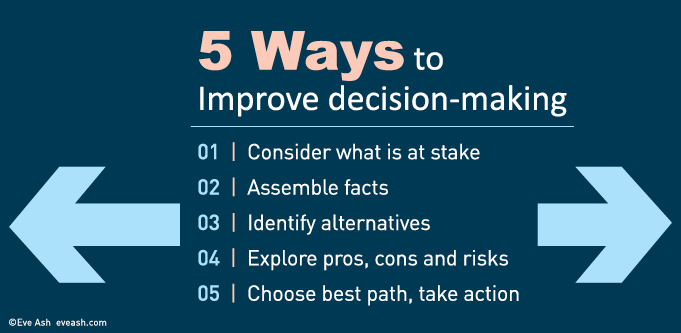Decision-making can be stressful. Not making decisions or making the wrong ones can be even more stressful.
What’s the difference between gung-ho and decisive? One is about diving in enthusiastically, often unthinkingly, the other takes into account the relevant factors before making a move. Gung-ho people are very definite about what they like and what they will or won’t do. This is sometimes confused with being decisive, or perceived as a way to improve decision-making. Oh, it’s better than dithering or vacillating, some will say — just do it.
Throughout history, rulers and leaders have been confronted with complex decisions, and this flows down to CEOs, board directors, middle management, and so on. For the majority of us with fewer wide-ranging dilemmas, making sensible decisions can nevertheless be stressful. Improved decisions are fostered via the following five steps.
1. Consider what is at stake
Yes, it’s usually best not to rush into action. Find somewhere quiet to think, away from those putting you under pressure, or give yourself a chance to “sleep on it” so that your mind peruses the issues and impacts without undue stress. Sometimes we must decide quickly, which can be uncomfortable, especially if you don’t like to be rushed. Request (if possible) an hour or more to mull things over without people in your face, demanding your input. Write down for yourself what you believe is at stake.
2. Assemble facts
Don’t assume you know everything about a given topic, or a choice that needs to be made. The truth is, we often don’t. You can really only make a decision based on the best information you have at the time. That’s why it’s vital to assemble facts, as many as are pertinent to what you’re contemplating. Be prepared, too, to question your assumptions.
3. Identify alternatives
Don’t prejudge outcomes; sometimes dilemmas are heightened by players whose personalities skew what’s going on. You might believe, for example, that So-and-So has got a situation stitched up, and the odds are against your succeeding. Economists will tell you there are always more variables (combinations of items or components) going on in situations than generally acknowledged. This is where you need to step back and identify alternatives. Seek others’ viewpoints when assembling facts — there may well be valid perspectives you hadn’t taken into account, which could present you with a course of action you hadn’t contemplated.
4. Explore pros, cons and risks
Don’t be impulsive — everyone flies off the handle at times and commits to a decision that is anything but in our best interests. I’ve previously written about “think before you rant” on social media. Explore pros, cons and risks; make this a requirement of yourself. Some call this cost-benefit analysis. With practice and a certain willingness to accept that few decisions are perfect anyway, you find that you improve your decision-making capability. By having chains of command with delegated responsibilities — this is how the military and the civil service have operated for centuries.
5. Choose best path, take action
Don’t over-analyse. The flipside of exploring pros, cons and risks is that sometimes people mull over a problem’s dimensions for days, becoming paralysed and feeling unable to commit to a course of action. There’s this or that person to consider, those consequences that might arise, and underlying it all is fear of making a mistake, one that could cost you, fear of what others might think, what they might do, and so on. Much of what happens in our lives is outside our control, but sometimes you have to decide matters based on what feels right for you, what is ethically sound and what the best information available tells you. On this basis, we choose the best path and take action.
Sometimes, “take action” might mean a decision to “do nothing” (because immediate action is not right). Sometimes your decision will be more aimed at a satisfactory (as distinct from optimal) outcome. This is known as satisficing and happens quite frequently as a mid-course decision, to enable distant goals to be achieved.
In the end, you need to be both realistic and aim for the best decision given the circumstances. It is possible to be both principled and fluid in your choices.
NOW READ: How to deal with decisions that make you feel sick
NOW WATCH: Making Decisions

